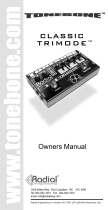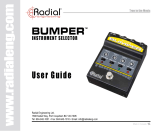Page is loading ...

www.radialeng.com
True to the Music
Radial Engineering Ltd.
®
®
True to the Music
USER GUIDE
Radial Engineering Ltd.
Classic V9
™
Classic V9
™
FEATURES
RADIAL ENGINEERING 3 YEAR
TRANSFERABLE LIMITED WARRANTY
RADIAL ENGINEERING LTD. (“Radial”) warrants this product to be free from defects in
material and workmanship and will remedy any such defects free of charge according to the
terms of this warranty. Radial will repair or replace (at its option) any defective component(s)
of this product (excluding nish and wear and tear on components under normal use) for
a period of three (3) years from the original date of purchase. In the event that a particular
product is no longer available, Radial reserves the right to replace the product with a similar
product of equal or greater value. In the unlikely event that a defect is uncovered, please call
800-939-1001 or email [email protected] to obtain an RA number (Return Authorization
number) before the 3 year warranty period expires. The product must be returned prepaid
in the original shipping container (or equivalent) to Radial or to an authorized Radial repair
center and you must assume the risk of loss or damage. A copy of the original invoice showing
date of purchase and the dealer name must accompany any request for work to be performed
under this limited and transferable warranty. This warranty shall not apply if the product has
been damaged due to abuse, misuse, misapplication, accident or as a result of service or
modication by any other than an authorized Radial repair center.
THERE ARE NO EXPRESSED WARRANTIES OTHER THAN THOSE ON THE FACE
HEREOF AND DESCRIBED ABOVE. NO WARRANTIES WHETHER EXPRESSED
OR IMPLIED, INCLUDING BUT NOT LIMITED TO, ANY IMPLIED WARRANTIES OF
MERCHANTABILITY OR FITNESS FOR A PARTICULAR PURPOSE SHALL EXTEND
BEYOND THE RESPECTIVE WARRANTY PERIOD DESCRIBED ABOVE OF THREE
YEARS. RADIAL SHALL NOT BE RESPONSIBLE OR LIABLE FOR ANY SPECIAL,
INCIDENTAL OR CONSEQUENTIAL DAMAGES OR LOSS ARISING FROM THE USE OF
THIS PRODUCT. THIS WARRANTY GIVES YOU SPECIFIC LEGAL RIGHTS, AND YOU
MAY ALSO HAVE OTHER RIGHTS, WHICH MAY VARY DEPENDING ON WHERE YOU
LIVE AND WHERE THE PRODUCT WAS PURCHASED.
Classic V9
™
User Guide - Part# R870 1018 00 / 09-2016 All rights reserved.
Specications and appearance are subject to change without notice.
Radial Engineering Ltd.
1588 Kebet Way, Port Coquitlam BC V3C 5M5
tel: 800-939-1001 • fax: 604-942-1010
[email protected] • www.radialeng.com
Circuit Type ................ Classic Class FET buffer and classic audio grade ICs
Post-Distortion High & Low EQ ........................Variable from -10dB to +10dB
High Shelf ..............................................Switchable high frequency boost/cut
Mid Boost ........................................ Switchable 0dB, +7dB, +12dB @ 500Hz
Gain Switch ........................................Increases saturation of the drive circuit
Output Gain .......................................... Variable from unity to +48dB @ 1kHz
Footswitch .................................................................. Latching bypass switch
Power ..................................................................9VDC, adapter not included
Radial Classic Specications
OVERDRIVE-DISTORTION PEDAL
1. 9VDC POWER: Connection for 9 volt (center negative) power adapter.
Includes a cable clamp to prevent accidental power disconnection.
2. OUTPUT: High-Z ¼” connection to your amplier.
3. INPUT: High-Z ¼” connection from your instrument.
4. EQ: Powerful dual band post-distortion EQ.
5. DRIVE: Used to ne tune the drive to suit your playing style.
6. RANGE: 3-position switch used to set the gain stage:
• Low – for slight signal breakup
• Med – for crunch
• High – for full on saturation
7. LEVEL: Used to set the overall output level.
8. HIGH: Used to compensate the top end for overly bright amps or amps
that may sound too dark.
9. MID: 3-position mid-boost with at, +7dB and +12dB to accentuate signal
for solos or to fatten up the tone of a single-coil pickup.
10. FOOTSWITCH: Activates the Classic V9 with LED indicator.
11. STEEL ENCLOSURE: Heavy-duty 14-gauge steel enclosure for long life.
7
8
9 10 11
5
6
1 2 3
4

Radial Engineering Ltd. Radial Engineering Ltd. Radial Engineering Ltd.
Classic V9
™
Classic V9
™
Classic V9
™
OVERVIEW
Thank you for purchasing the Tonebone Classic V9… what will likely be the
most inspiring distortion pedal you have ever played. It is not only quiet, it
is dynamic. This means that each note responds to your playing just like a
real guitar amp.
Before you start playing, please take a moment to read through this short
manual. This will not only guide you through the functions, but also give you
some hints on how to best approach your tone. After you have done your
homework, if you nd yourself asking questions that you feel are unanswered,
please visit the Classic V9 FAQ page on the Tonebone site. This is where
we post updates and questions from users like yourself. If you still feel the
need to communicate, feel free to drop us an email at [email protected]m
and we will do our best to reply in short order.
Now get ready to grind, spit and slug like a winning prize ghter!
MAkING CONNECTIONS
Like most other pedals, the Classic V9 employs a standard 9 volt Boss
®
style power supply (not included). You can also use your power brick to
deliver power. Make sure the polarity is correct with center pin negative.
Connecting to and from the Classic V9 is done using standard ¼” coaxial
guitar cables. Using high quality cables will help reduce susceptibility to
noise. Before making any connections, make sure your amp is turned down
or off. This will eliminate turn-on transients that can cause damage to your
loudspeakers. Connect your guitar to the Classic V9’s input and your amp
from the V9’s output.
ADjUSTING THE TONE
The Classic-V9 employs a super powerful post-distortion EQ circuit that
affects both the tone and the output level. This delivers exceptional control
over the tone and works tremendously well when tone shaping with your amp.
Try adjusting the HIGH and LOW equalizer and you will quickly become
aware of the power that is in these two controls. Radical EQ changes will
also produce tremendous level changes.
There are two other switches that work in conjunction with the EQ. The
MID and the HIGH switch. The 3-position MID can be used for a number of
circumstances. If you are using single-coil pickups, you can use it to fatten
up the tone. It is also great to add mid-range to your tone when soloing. This
not only helps the guitar cut through, it also increases sustain without the
need for extra distortion or a compressor.
The HIGH switch is used to set the V9’s overall tone. For instance, when
using an overly bright amp like an old Marshall® or Ampeg®, taming the high
end by setting the switch in the down position can dramatically improve the
tone. Think of Jeff Beck… his tone is dark, yet unmistakably his. You can also
brighten up the top end like a presence switch on an amp. This is often used
to accentuate the harmonics when a greater degree of distortion is being used.
The last control is the LEVEL knob on the far left. This is used to set the
nal output. By combining the drive, EQ settings and LEVEL, you can set
the Classic V9 to integrate with any amp or pedalboard setup.
GETTING STARTED
To start, set all of the rotary control knobs to the 12 o’clock position and the three
3-position switches to the middle [start position]. This will let you better explore
each function as we go through them. Turn on your amp and then bring up the
volume slowly. You should always test at a low volume as this prevents loud
pops from occurring should a cable or power supply not be properly seated. Set
your amp to a clean tone. When ready, activate the Classic V9 by depressing the
footswitch. The LED will illuminate to let you know power is present.
SETTING THE DISTORTION
There are two controls used to set the desired level of distortion. The rst is a
3-position RANGE switch that lets you set the type of distortion you want. Unlike
other pedals that are full on or off, the Classic lets you focus the distortion to suit
your style of play. If you tend to be on the bluesy side of things, try setting the
RANGE to low or mid and then ne tune the distortion using the DRIVE control.
For fun, try reducing the output level on your guitar by turning down the volume.
You will notice that the Classic V9 reacts to this by cleaning up. This also allows
you to dig into your notes to add dynamics and a greater degree of feel. If you
prefer the heavy side of things, set the RANGE switch to the top position. This
adds more distortion and harmonics.
start position
• High – for full on saturation
• Med – for crunch
• Low – for slight signal breakup
BUFFER
INPUT
DRIVE
TONE
SHAPING
BRIGHT
OUT
+12dB
+7dB
MID
TONE CONTROLS
HIGH
LOW
LEVEL
OUTPUT
INPUT
DRIVE
STAGE
LOW
MID
HIGH
GAIN RANGE
LOW
MID
HIGH
/







